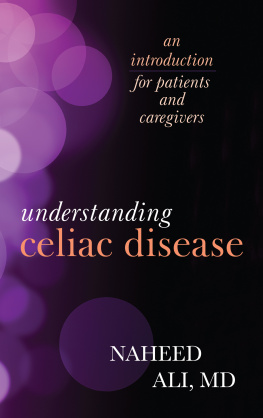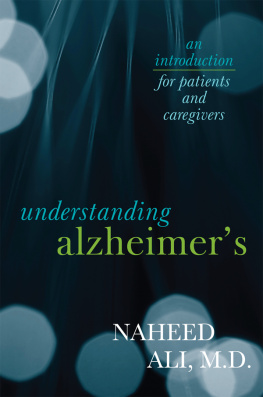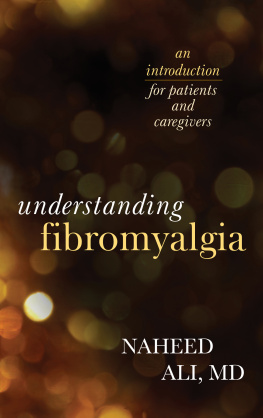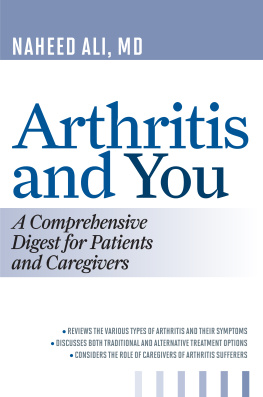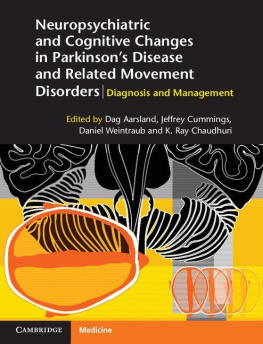Understanding Parkinsons Disease
Understanding Parkinsons Disease
An Introduction for Patients
and Caregivers
Naheed Ali
ROWMAN & LITTLEFIELD PUBLISHERS, INC.
Lanham Boulder New York Toronto Plymouth, UK
Published by Rowman & Littlefield Publishers, Inc.
A wholly owned subsidiary of The Rowman & Littlefield Publishing Group, Inc.
4501 Forbes Boulevard, Suite 200, Lanham, Maryland 20706
www.rowman.com
10 Thornbury Road, Plymouth PL6 7PP, United Kingdom
Copyright 2013 by Rowman & Littlefield Publishers, Inc.
All rights reserved. No part of this book may be reproduced in any form or by any electronic or mechanical means, including information storage and retrieval systems, without written permission from the publisher, except by a reviewer who may quote passages in a review.
British Library Cataloguing in Publication Information Available
Library of Congress Cataloging-in-Publication Data
Ali, Naheed, 1981- author.
Understanding Parkinson's disease : an introduction for patients and caregivers / Naheed Ali.
p. cm.
Includes bibliographical references and index.
ISBN 978-1-4422-2103-1 (cloth : alk. paper) -- ISBN 978-1-4422-2104-8 (electronic)
I. Title. [DNLM: 1. Parkinson Disease -- diagnosis. 2. Parkinson Disease -- therapy. WL 359]
RC382
616.8'33--dc23
2013021782
This book represents reference material only. It is not intended as a medical manual, and the data presented here are meant to assist the reader in making informed choices regarding wellness. This book is not a replacement for treatment(s) that the readers personal physician may have suggested. If the reader believes he or she is experiencing a medical issue, professional medical help is recommended. Mention of particular products, companies, or authorities in this book does not entail endorsement by the publisher or author.
The paper used in this publication meets the minimum requirements of American National Standard for Information Sciences Permanence of Paper for Printed Library Materials, ANSI/NISO Z39.48-1992.
Printed in the United States of America
Also by Naheed Ali
Arthritis and You: A Comprehensive Digest for Patients and Caregivers
Understanding Alzheimers: An Introduction for Patients and Caregivers
The Obesity Reality: A Comprehensive Approach to a Growing Problem
Diabetes and You: A Comprehensive, Holistic Approach
Understanding Parkinsons Disease is dedicated to my readers, to
Parkinsons disease patients, and to all who provided encouragement and support for my research.
Preface
The brain is in charge of a humans sensations, feelings, memory, personality, and movements. Brain cells, also called neurons, are able to send signals and communicate with one another through neurotransmitters such as dopamine, acetylcholine, serotonin, and norepinephrine, which are chemical messengers released by neurons and produced in different parts of the brain. Unlike the cells in other human organs, neurons are not replaced with new ones when they die.
The neurons in the substantia nigra produce the melanin-pigmented dopamine, which is the chemical messenger in control of transmitting signals between the substantia nigra and the striatum, the next relay station of the brain. This transmission of signals between the two components of the basal ganglia permits the smooth, coordinated function of the bodys movement and muscles. Losing this type of neuron (1) decreases the amount of melanin-pigmented dopamine released and (2) impairs the smooth communication between the substantia nigra and striatum, resulting in Parkinsons disease. This deficiency is pathologically manifested by loss of dark coloration, also called depigmentation, in the substantia nigra. Round inclusions made up of protein can be seen in the damaged or depigmented (lost dark pigments, or neuromelanin) substantia nigra, and they are called Lewy bodies. Lewy bodies are more than fifteen microns in diameter and have an organized structurea dense core surrounded by a halo. These inclusions, which are a hallmark of the disease, are visible only through a microscope, that is, their existence in the brain can be verified only during an autopsy.
Uncovering Parkinsons
Parkinsons disease is characterized as a common, chronic, neurodegenerative movement disorder, manifested by (1) tremors (shaking), (2) stiffness (rigidity), (3) slowness (bradykinesia), (4) balancing difficulty (posture instability), and (5) multitasking issues. and although the disease is slowly progressive, the rate of neurodegeneration varies for each patient.
The disease is just one type from a wider group of movement disorders called Parkinsonism or Parkinsonian syndrome (a more generic term), a group of diseases that are all linked to inadequate dopamine in the basal ganglia, manifesting in impairments similar to those of Parkinsons disease. and there will be none until the causes are determined in full. Treatments are availablemedical, surgical, complementarythat are proven to alleviate the symptoms and improve the quality of lives of patients, with the help and support of caregivers around them.
The Gain from Reading about Parkinsons
There are no cultural, geographical, or gender boundaries for who can be affected by Parkinsonsthat is, anyone can be afflicted. Being aware of the disease, the symptoms, and the complexity of the brain and the disease itself, readers can help save someone they know and most especially someone close to them, such as family or friends, whom they might suspect to have Parkinsons disease. Diagnosis can be very difficult and uncertain. In some cases, someone diagnosed with Parkinsons disease does not actually have the disease, and in others, someone diagnosed with a different illness was actually manifesting Parkinsons. Many people assume that the early stages and symptoms of the disease are signs of natural aging or another illness since the disease is subtle at first. Friends and families may be the first to notice the symptoms, and early signs are difficult to detect.
Knowing that anyone can become a victim of Parkinsons disease, I sincerely hope that readers will be more observant of themselves and the people around them. Reading literature about the disease will equip them with the understanding of what it is and what it is not, its common symptoms, and the things one can do as concerned citizens (chapter 20) to contribute and to help other peoples lives. Once diagnosed, it is important for both the patient as well as his or her family to cope in the process. Acceptance and adaptation are fundamental requirements in coping with a chronic progressive disease such as Parkinsons disease. Family as well as healthcare professionals are affected in the process. It is strongly recommended for the spouse or family caregiver to also take care of themselves in the process.
Resources on Parkinsons disease such as Understanding Parkinsons Disease are accessible to inform them of all the possibilities they might encounter and thus avoid any fear of the uncertainties. These references provide them and their caregivers (1) the different approaches to managing and monitoring of Parkinsons, (2) types of treatments and medications available, (3) required changes in lifestyle, and (4) common problems and issues encountered by other Parkinsons disease patients and caregivers, from which they can learn. These texts also provide information on services and organizations that are accessible for further support, advice, and assistance to both the patient and the caregiver. Current progress and remaining challenges in Parkinsons disease research are also being disseminated. All these are done to continually reassure patients and caregivers about the availability of proven effective medications and treatments and encourage them that there is hope to help them cope with and end the clinical adversary they are facing. Their optimism is important as it indicates their willingness to adapt to changes imposed by the disease. Last, these pages are written and distributed to let them know and feel that they are not alone in the process.
Next page

